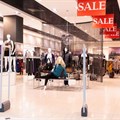
Subscribe & Follow
Advertise your job vacancies
#Level3Lockdown: Uncertainty, risks remain for retailers and retail property owners
As South Africa gradually heads towards Level 3 lockdown as from 1 June, the opening of most retail means that retailers and retail property owners will begin to look forward to a more normal business life.

Image source: Gallo/Getty
Moving gradually to lower levels of lockdown should mean that the retail property sector can look forward not only to an increasing number of their tenants reopening, but also to foot traffic increasing along with spending.
But even with the lockdown being phased down, and eventually out, there are no guarantees that the “full” consumer recovery will be quick. Rather, full recovery could conceivably lag the end of lockdowns considerably, given the magnitude of the financial “knock” that the household sector has taken.
Unrealistic assumptions
A simplistic assumption may be that household disposable income returns to its pre-Covid-19 crisis level, consumer spending follows suit and also returns to its pre-Covid-19 level, and this translates into retail sales returning to similar levels too, all fairly quickly once lockdown is fully phased out.
But such assumption may be unrealistic. One should assume that a portion of the more “financially fragile” businesses in the country won’t make it past the full lockdown period, with a loss of revenues of even a few months being more than they can manage.
How big this group of businesses at risk is, is difficult to tell, but it was probably a growing number in recent years, and indeed all three major categories of commercial property had seen mild increases in their average vacancy rates and bad debt levels in recent years.
This means that a portion of the country’s production capacity has likely been damaged, remaining damaged even after the lockdown is over, lowering its potential output. That contributes to post-lockdown employment constraints, which dents household income in the longer run too.
This makes it likely that in the post-lockdown phase, the country’s consumer demand won’t immediately recover “fully” to pre-Covid-19 levels.
Contraction in real household sector disposable income
FNB’s forecasts project accordingly. During 2020, real household sector disposable income is expected to contract by -7%, causing a simultaneous decline in real household consumption expenditure to the tune of -7%. A significant growth rebound off the lower 2020 base is foreseen in a post-lockdown economy, but forecasts of +3.2% and +0,5% growth for 2021 and 2022 respectively in both real household disposable income and real household consumption expenditure means that even by 2022, the level of real household consumption expenditure will still be -3.54% below the level in the pre-Covid year of 2019.
This long and slow road out of the “dip” is not unrealistic, given what we’ve mentioned about a portion of businesses (production capacity) and jobs having closed down more permanently, and not returning immediately after lockdown.
The implication for retailers, and the centres in which they operate, is that after lockdown (which is assumed in the forecasts to be virtually entirely over before the end of 2020), the retail economy will indeed improve significantly from lowly lockdown levels, but only back to a “normal recessionary” environment, with real consumer spend levels remaining below 2019 levels for a few years to come.
Granted, in nominal terms, household consumption expenditure next year is projected to be a mild 2.62% higher than that of 2019, after dipping by a forecast -4% in 2020, but that would mean that it hasn’t nearly kept up with general price inflation, and likely not with retailers operating costs either.
“Wildcard” risks to retail expectations and forecasts
Besides the normal hazards with forecasting the magnitude of the economic contraction, and the resultant impact on employment and household income growth (decline), a big unknown is the impact of the corona crisis on “confidence and sentiment”.
Virus-related fear of crowded public spaces
One area of confidence that is being spoken about a lot, as certain countries or states “open up”, relates to the confidence of the public to return to crowded public spaces, of which retail centres are one such example.
Essential item shopping, such as the visits of consumers to the supermarkets throughout the Covid-19 lockdowns are unlikely to be avoided. But in the area of “lifestyle”, for example gyms, dining at restaurants, visiting pubs, cinemas, ice rinks and bowling alleys, the attitude may be significantly different, as it may be with “postponeable” and non-essential/luxury goods purchases. While predicting the magnitude of possible virus-related consumer caution is impossible, we would expect some impact to be prevalent for as long as the virus lingers.
Fear of crowded public spaces doesn’t necessarily curb consumer spending, however. Rather, it may play into the hands of online retailers and food deliveries, even after lockdown is entirely ended.
Perhaps making this “fear” factor less of a threat to retail centres in SA than in certain parts of the US and Europe, for instance, is South Africa’s (to date) still relatively low Covid-19-related death rate. But time will tell.
Financial health fears and increased savings – the less talked about wildcard
But the “wildcard” retail risk that’s being talked about far less, it seems, is the possibility of far greater future financial caution, and its impact on consumer spending.
In this very deep recession that appears to be unfolding, the employment loss and decline in real incomes appears to be severe. While automatically curbing the spending of many who have lost jobs and incomes (and who don’t always have wealth buffers built up to see them through), it is possible that this can also put fear into the minds of those households that have not suffered a loss of employment of income.
Job losses are well publicised, and many people will actually know others that have lost either their business income or their personal income.
Many people, even highly skilled people, may become acutely aware that employment opportunities are not in abundance.
Add to this that many households would have seen a decline in their net wealth with the onset of Covid-19, and even for a while prior to this crisis, with the economy having stagnated since around 2012.
It is this environment that has the potential to create a widespread concern amongst households over their longer term financial future, and that in turn has the potential to cause the household sector to meaningfully increase its savings rate.
A significant increase in the savings rate in a time of income decline or low income growth would mean further downward pressure on household consumption expenditure and retail sales growth. It would mean the risk that our assumption that consumer spend grows in line with the growth rate in disposable income would be over-optimistic.
How realistic is the possibility of a significant increase in the household sector’s savings rate?
Has there been any evidence of a move to lift the net savings rate (gross saving less depreciation on fixed assets)? Yes, but only mild attempts in SA’s recorded history:
- The 1977 GDP contraction, the year after the Soweto Uprisings saw household net savings as a percentage of disposable income rise from 3.7% in 1976 to 7.5% in 1977.
- The double-dip recession of 1982-1985 saw this net savings rate rise from 1.6% in 1982 to 4.4% in 1985.
- The three-year recession of 1990-1992, accompanied by SA’s volatile political transition, saw net savings rise from 2% in 1991 to 4.1% in 1992.
- Around the 2008/9 Global Financial Crisis, and again following the onset of SA’s long-term growth stagnation from 2012 onward, we saw mild “improvements” in the form of diminishing net dis-savings rates too.
So there have been mild hints of a move to lift the savings rate in tougher and more uncertain times, and we believe that this is based on heightened concern regarding households’ own financial future that come with a weaker economy and/or political and policy uncertainty.
Admittedly, none of the economic shocks over the past 60 years have been sufficient to do more than lift the savings rate mildly and temporarily, while the longer term broad trend in savings has been one of decline.
So can a big enough economic shock cause a more significant and sustained rise in household savings? Looking elsewhere for a longer data history, it appears that this is perhaps possible. For evidence of a prior long upward savings rate cycle, we turn to the United States, where a longer data history exists than in South Africa.
From the Bureau of Economic Analysis, at the University of California, US personal savings rate data going back to 1900 is available. It shows this savings rate being weak in the initial stages of the 20th century, before embarking on a long term up-cycle that had its roots in a below-zero rate around the time of the Great Depression, thereafter rising to a high (ignoring an abnormal World War II spike, which may have had much to do with consumer product supply constraints too) of near 13% by the early-1970s.
Understanding savings behaviour
Savings behaviour and all of its drivers have proved difficult to fully understand over the years, but a long term rising trend in US savings following the Great Depression many years ago, and through a World War, is interesting to take note of at the current time when an extreme economic contraction is unfolding.
In South Africa’s more recent savings history, negative economic shocks appear to have been accompanied by mild savings rate “increases”.
Zooming in on savings trends of the past two decades in South Africa, the economic slowdown/recession of 2008/9 appeared to prompt a temporary improvement in household savings (diminishing in net dis-savings), as has the more recent economic growth downturn which started around 2012.
From a net-dissaving rate of -2.5% of disposable income as at the final quarter of 2013, this rate has diminished to -0.2% as at the end of 2019.
The magnitude in savings "improvement" has not been large in the most recent multi-year downturn to date. But the question is whether it is now time for the net savings rate to turn significantly positive, given the extreme magnitude of the current economic shock unfolding.
Key near-term risk factor
Weak and uncertain economic times appear to motivate savings, and a massive GDP contraction of -8% is forecast for 2020 in what appears to be the biggest recession in post-World War II history unfolding.
It is difficult to know what magnitude of crisis is needed to send households into a major savings drive. But this “increased savings and financial caution” possibility must be flagged as a key near-term risk factor to retail and retail centre performance, over and above the recessionary income “knock” that many households have taken, and along with the possible virus-related fears related to visiting these centres.
The post-lockdown road to recovery for retail property looks likely to be a lengthy one, with household finances and confidence-related factors being crucial.
About John Loos
John Loos, property sector strategist at FNB Commercial Property FinanceRelated
Interest-rate cuts hint at a revival in residential construction for 2025 25 Feb 2025 Clur Index: 2024 ends on a high note for SA's shopping centres 18 Feb 2025 #BizTrends2025: Cautious optimism for better times, but risks are abundant 23 Jan 2025 Community and smaller shopping centres shine as new retail frontier emerges - Clur Index 6 Sep 2024 #WomensMonth: Melinda Isaacs, seasoned development executive at Liberty Two Degrees 26 Aug 2024 Milestone as Growthpoint boosts Clur index 1 Aug 2024












